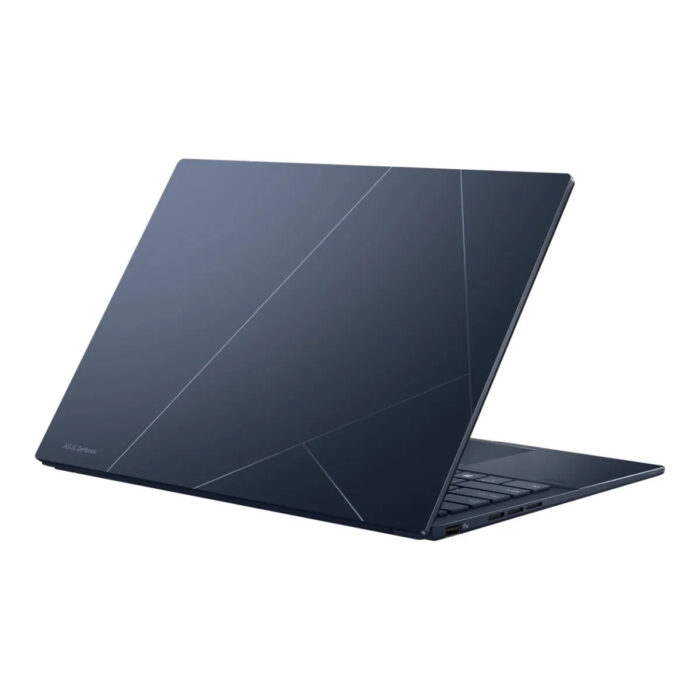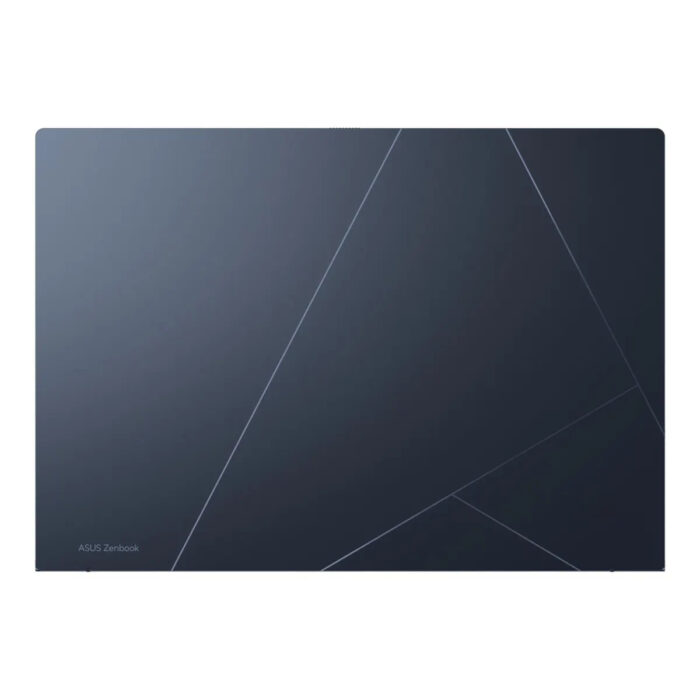Asus is one of the top laptop brands to consider when buying a new laptop. The ASUS Zenbook 14 OLED UX3405 comes with an Intel Core Ultra 7 155H processor. Not only is it tailored for business professionals, but it also meets the needs of graphic designers, thanks to its OLED display and Intel Arc graphics, which make it stand out.
Its OLED screen boasts a 2.8K resolution and a 120Hz refresh rate. The laptop comes with 32 GB of LPDDR5x RAM and a 1 TB of PCIe 4.0 SSD.
Specifications
| Screen | 14.0-inch, 3K (2880 x 1800) OLED, 16:10, 0.2ms, 600nits, 100% DCI-P3, 1,000,000:1, 1.07 billion colors, Glossy, 70% less harmful blue light, 87% screen-to-body ratio |
| Processor | Intel Core Ultra 7 processor 155H (24MB Cache, up to 4.8 GHz, 16 cores, 22 Threads), Intel AI Boost NPU |
| Wireless Connection | Wi-Fi 6E (802.11ax) (Dual band) 2×2 wireless card, Bluetooth 5.3 |
| Graphics card | Intel Arc Graphics |
| Memory | 32GB LPDDR5x on-board dual-channel memory. |
| Storage | 1TB M.2 NVMe PCIe 4.0 SSD |
| Camera | FHD camera with IR function, privacy shutter |
| Ports | 1x USB 3.2 Gen 1 Type-A 2x Thunderbolt 4 1x HDMI 2.1 TMDS 1x 3.5mm Combo Audio Jack |
| Battery | 75Wh, 4-cell Li-ion battery with 65W AC adapter |
| OS | Windows 11 Home |
| Weight | 1.28 kg (2.82lbs) |
Design

The dimensions of the ASUS Zenbook 14 OLED are 312.4 x 220.1 x 14.9 mm, and it weighs just 1.28 kg. It is available in two elegant colors: Ponder Blue and Foggy Silver, and this time, we are introducing the Reflection Blue variant. This color scheme is distinguished by its elegance and subtle allure to cater to the tastes of business people. The exterior of the display is designed in a minimalist style, with four modest straight lines skillfully converging to form the letter “A”, giving it a sense of simplicity and sophistication.
The OLED display has slim bezels on both sides and a slightly wider bezel at the top, which can accommodate a webcam, microphone, and other sensors. This laptop can be opened up to 180 degrees, making it easy to use at various angles to suit different user preferences.

Display
The ASUS Zenbook 14 OLED UX3405 comes with a 14-inch OLED display with a 2.8K resolution (2880 x 1800) and a 120Hz refresh rate. The screen has a 16:10 aspect ratio, a four-sided micro-bezel design, and a screen-to-body ratio of up to 88%. The response time of this display is only 0.2 ms, while according to the official specifications, it can reach a maximum brightness of 600 nits.

According to official claims, the display covers 100% of the DCI-P3 color gamut with 1.07 billion display colors and a 1,000,000:1 contrast ratio. The display has also received several prestigious certifications, including the SGS Eye Care Display (which reduces harmful blue light by 70%), TÜV Rheinland certification, and VESA CERTIFIED Display HDR True Black 600.
When we tested this screen with the Spyder X tester, the display covered 100% sRGB, 88.9% Adobe RGB, and 100% DCI-P3 color gamuts. It supports four professional color gamut switching options. In DCI-P3 color gamut mode, we tested it, and the results showed an average display color deviation value of 0.57 and a maximum value of 2.57.
Screen Test Results | |
| sRGB | 100% |
| Adobe RGB | 89% |
| DCI-P3 | 100% |
| Maximum Brightness | 600nits |
| Average Delta E | 0.58 |
| Maximum Delta E | 2.56 |
Keyboard and TouchPad
The ASUS Zenbook 14 OLED comes with a backlit Chiclet keyboard, but it doesn’t have a numeric keypad. The lack of a numeric keypad is commonplace in laptops with 14-inch displays, with a uniform dark blue color across the entire keyboard surface and slightly lighter key colors. The key travel is only 1.4 mm, and there is no common click sound, making for a pleasant typing experience. The keyboard supports a single-light backlit, enhancing visibility in different lighting conditions.

Below the display, a large touchpad takes center stage with a sunken design. The large touchpad area allows for quick navigation and a smooth user experience.
Ports
To achieve the slim profile of the laptop, ASUS has made some compromises regarding ports. The ASUS Zenbook 14 OLED has a total of five ports. On the right side, there are two Thunderbolt 4 Type-C ports, a 3.5mm headphone jack, and an HDMI 2.1 port. Meanwhile, there is only one USB 3.2 Type-A Gen 1 port on the left side.

ASUS also offers a USB-A to RJ45 Gigabit Ethernet adapter, an accessory that allows users to connect a network cable for faster internet speeds. While the ports provided are suitable for everyday office use, it’s a good idea to choose a USB docking station for users with more extensive connectivity needs.
Battery and Charging
The Asus Zenbook 14 OLED comes with a 75Wh 4-cell Li-ion battery (9420mAh). According to the official specifications, this battery can last for more than 15 hours under normal usage conditions.
To verify this claim, we conducted a battery test by playing a local video with the screen brightness set to 80% and the volume at 40%. After nearly two and a half hours of playback, the battery capacity remains at 80%, indicating that the notebook’s battery performance is satisfactory.
The Asus Zenbook 14 OLED comes with a 65W Type-C adapter. It can take only 45 minutes to charge 60% of the battery.
RAM and SSD
The laptop comes with 32GB LPDDR5X dual-channel memory with speeds of up to 7467 MT/s. It’s worth noting that the memory is soldered to the motherboard, so it can’t be upgraded. However, for those with limited or lower requirements, 8GB and 16GB RAM configurations are also available.
The model we reviewed comes with a 1TB M.2 NVMe PCIe 4.0 SSD. The laptop only offers one M.2 slot, which means that any storage upgrade will require replacing the existing SSD.
To test the performance of the SSD, we used the CrystalDiskMark benchmark application, and the results were as follows: 5,005 MB/s for sequential read, 3,545 MB/s for sequential write, 43 MB/s for 4K random read, and 81 MB/s for 4K random write. These benchmark data indicate that the SSD’s performance is outstanding, confirming its ability to meet the demands of various computing tasks.
CPU Benchmark
The ASUS Zenbook 14 OLED is equipped with an Intel Core Ultra 7 155H processor. Compared to the previous generation of Intel i7 processors, there is a 20% increase in performance and improved energy efficiency. This processor features 16 cores, 22 threads, and 24MB of L3 cache memory, with a peak frequency of up to 4.8 GHz and a TDP of 28 W.
The ASUS Zenbook 14 OLED is also available with other processor options, including the Intel Core Ultra 5 125H and the Intel Core Ultra 9 185H.
The processor also integrates Intel Arc graphics with a core frequency of up to 800 MHz, which is nearly twice the performance of the previous generation of integrated graphics. It supports 8K 10-bit HDR and AV1 codecs. The processor has a built-in AI NPU that delivers an 8x increase in AI efficiency.
To test the CPU and its integrated GPU, we did some benchmarks, which are as follows:
Cinebench R20: 689cb on single-core and 5,459cb on multi-core
Cinebench R23: 1,796pts on single-core and 14,067pts on multi-core
CPU-Z: 697.1 points on single-threaded and 7,128.3 points on multi-threaded
Here are the benchmarks for the GPU:
3DMark Time Spy: 3,691 points
3DMark Wild Life Extreme: 7,035 points
The CPU performance of the Asus Zenbook 14 OLED proved to be very commendable, exceeding benchmarks when compared to other commercial laptops. Additionally, the graphics card’s performance is comparable to the GTX 1650.
Heat Dissipation
To improve heat dissipation efficiency, there are many vents at the bottom of the laptop. On the left side, there are three vents that contribute to the cooling system.
After removing the back cover, we found that the cooling system has a single cooling fan and dual heat pipes.
During the benchmarking, we took temperature measurements of the laptop to evaluate its cooling performance. The highest temperature in the middle and upper part of the keyboard area reached 39.1°C. It is worth noting that the noise emitted by the cooling fan was kept to a minimum to ensure user comfort.
Also Read: HP Pavilion Plus 16 (2023) Review
Summary:
The ASUS Zenbook 14 OLED UX3405 is the flagship in the business segment. It is powered by the Intel Core Ultra 7 155H processor, which meets the needs of professionals and graphic designers. Its standout features include a 2.8K OLED display with a 120Hz refresh rate, a 75Wh battery, 32GB LPDDR5x memory, and a 1TB PCIe 4.0 SSD. Its cooling system provides excellent heat dissipation performance, keeping fan noise to a minimum while maintaining efficient thermal management. The laptop offers a comprehensive solution for business and creative professionals.